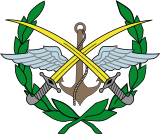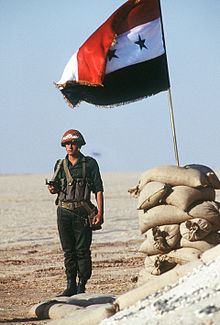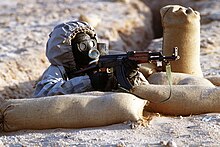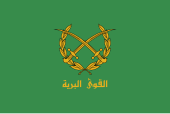Armed Forces of Syria
|
|||

|
|||
| guide | |||
|---|---|---|---|
| Commander in Chief : | President Bashar al-Assad | ||
| Defense Minister: | Ali Abdullah Ayyoub | ||
| Headquarters: | Damascus | ||
| Military strength | |||
| Active soldiers: | 80,000 to 100,000 | ||
| Conscription: | Yes | ||
| Eligibility for military service: | 18 years | ||
| household | |||
| Military budget: | $ 2,495,000,000 ( Rank 59 ) | ||
| Share of expenses from tax revenue: | 4.1% (2012) | ||
| Share of gross domestic product : | 4.1% | ||
| history | |||
| Founding: | 1946 | ||
The armed forces of the Syrian Arab Republic ( Arabic القوات المسلحة العربية السورية, DMG al-quwāt al-musallaḥat al-ʿarabīyat al-sūrīya ) had a total of around 300,000 soldiers before the outbreak of the civil war in 2011 and consisted of an army , navy and air force . The Supreme Commander of the Armed Forces is the President of the country Bashar al-Assad . The armed forces suffered heavy losses in the ongoing war; the remnants were estimated in October 2015 at a total strength of 80,000 to 100,000 soldiers.
General
Conscription is compulsory in Syria . All male Syrians under the age of 18 are required to do 24 months of military service. The most important arms supplier to Syria was the Soviet Union until 1989 ; to this day, most of the Syrian weapon systems originate from the production of the former Eastern Bloc . Since 1989 there have been considerable bottlenecks in the supply of spare parts.
Strategically and tactically, the armed forces are also geared towards old Soviet military doctrines .
Since the civil war, the armed forces have suffered significant losses from desertification as well as losses from fighting . The process of disintegration of Syrian society along ethnic and religious borders accelerated this process and led to an unfavorable strategic situation in which the remaining forces are overstretched.
army

The Syrian Army is the largest branch of the armed forces . It had a strength of around 350,000 men until the civil war in 2011 and was divided into:
- 3 Army Corps ( I. , II. And III. Corps )
- 1 division of the Republican Guard (one artillery regiment , one mechanized brigade and three armored brigades)
- 7 airborne brigades
- 2 tank brigades
- 4 mechanized infantry brigades
- 10 special forces battalions (including: Republican Guard , Tiger Forces )
- 2 artillery brigades
- 2 independent anti-tank brigades
- 3 artillery rocket brigades (each with 3 battalions ), one brigade each with FROG-7 , SS-21 Scarab and R-17 .
- 2 missile defense brigades stationed on the coast, one of which is SS-C-1B Sepal and the other is equipped with P-15 Termit , SS-C-3 Styx can alternatively be assigned to the two brigades.
- 1st Coast Guard Brigade
The most important weapon systems were around 4,700 main battle tanks until 2011 , the most modern of which were 1,400 of the T-72 type . In addition, around 2,000 outdated T-55s and 1,000 T-62s were part of the arsenal. Even then, many tanks were no longer drivable, but built into battle positions. Most of the 3,800 armored personnel carriers belonged to the outdated BMP 1 model , but there were 200 to 350 more modern BMP 2 and BMP 3 vehicles. The artillery had around 2,600 guns, including 600 each of the Soviet types D-30 and M-46 . There were also around 450 self-propelled guns, mostly of the 2S1 type with a caliber of 122 millimeters.
The anti-aircraft troops within the army were unusually large with 60,000 men and, in addition to around 4,000 guns, had the comparatively advanced S-200 , 2K12 Kub , 9K34 Strela-3 , 9K35 Strela-10 (with 4,000 rockets the most numerous system) and 9K33 Osa , some of which were stationed in stationary missile bases near Damascus and Aleppo. However, it was planned to put the modern Russian 96K6 Panzir and S-300 systems into service.
The 18,000-man border guard were also part of the army, as were around 8,000 paramilitary gendarmes . In addition, there was an army brigade that was specially trained and equipped for coastal defense, as well as a missile brigade that had FROG , Scud series B and C missiles and, as the most effective weapon, the SS-21. The army reserve consisted of one armored division, four armored brigades, two tank regiments, 21 infantry and three artillery regiments.
Air Force
The Syrian Air Force ( Arabic القوات الجوية العربية السورية, DMG al-Quwwāt al-Ǧawwiyya al-ʿArabiyya as-Sūriyya ) were founded in 1948.
Before the civil war of 2011, the regular staff consisted of around 60,000 men. They were divided into ten or eleven attack and sixteen interception squadrons as well as two transport and one training squadron. The aircraft arsenal of a good 600 machines consisted mainly of MiG-21 (around 100) and MiG-23 (around 160) as well as Su-22 (around 50). The number of modern combat aircraft was significantly smaller: 20 Su-24s , a good 10 MiG-25s and 30 MiG-29s each . The helicopter fleet consisted of almost 100 Mil Mi-8 attack helicopters .
In addition to the six civil airports , which are also used by the military , the air force also had a further 17 military airfields , almost all of which are concentrated in the western part of the country.
marine
The Syrian Navy was disproportionate to the rest of the armed forces. Before the civil war it consisted of around 4,500 men, 2 corvettes , 16 rocket boats and some smaller surface units. The navy does not act as a separate armed force, but is integrated into the command structure of the army.
Weapons of mass destruction and launch vehicles
Nuclear weapons
Syria has ratified the Nuclear Non-Proliferation Treaty and currently has neither a nuclear weapons program nor a nuclear weapon system. However, Syria is accused of secretly working to build nuclear weapons. On September 6, 2007, Israeli fighter planes destroyed the El Kibar military facility in the east of the country as part of Operation Orchard . It is speculated that the facility was a North Korean- style nuclear reactor . According to the IAEA , processed uranium is said to have been found there, suggesting a connection to a secret Syrian nuclear program. The US government accuses Syria of cooperating with North Korea, but this is denied by the Syrian side.
Chemical weapons
Syria had since 1973, in connection with the Yom Kippur War , mustard gas , which was supplied by Egypt. As a result, Syria built up its own capacities for the development and production of chemical warfare agents. Syria had had sarin since the mid-1980s , possibly also VX . Syrian chemical weapons production is said to have been dependent on the supply of technology and raw materials from abroad. Evidence for the first use of sarin in connection with the civil war in Syria has been known since March 24, 2013, but it has still not been conclusively clarified whether it was actually used by the Syrian armed forces, for example in the poison gas attacks in Ghouta in August 2013. In the same year, Syria joined the Chemical Weapons Convention. On July 13, 2016, the OPCW General Director stated that "contrary to previous assurances by the Syrian government," OPCW experts had found evidence of other chemical warfare agents. Syria has admitted "the research and development of another chemical warfare agent".
Missiles
According to US data, the Syrian missile arsenal comprised more than 250 to 350 Scud-B and a similar number of SS-21s as of 2000. These rockets are primarily equipped with mobile launch pads. For the Scud-B and C systems, 26 of these ramps are estimated. The most modern rockets are likely to be around 50 Scud-C with 18 mobile launch pads. In addition, Syria has further developed the Scud with North Korean and Iranian help. This type, designated Scud-D, has an increased range of around 700 kilometers but a lower weapon load and lower accuracy than Scud-B and -C.
History of the armed forces of Syria
Colonial times
After the collapse of the Ottoman Empire , France took control of Syria through a League of Nations mandate . In 1919 the mandate power founded the Troupes spéciales du Levant as auxiliary troops, primarily against domestic political unrest. From these 8,000 men both the armed forces of Syria and Lebanon developed . Right from the start, the French authorities preferred members of the Alawi, Druze and Christian ethno-religious minorities among the teams and NCOs . In the later course of the year, the French mostly resorted to these population groups for officers. For these people, military service means the possibility of social and economic advancement. Tribes, even within the preferred ethnic groups, who had previously rebelled against the colonial power, were largely excluded. The urban Sunni elite that had grown up under the Ottomans were largely reserved about military service and often took the opportunity to withdraw from service in return for paying a special tax.
Palestine War
During the Palestine War of 1948/49, Syria deployed brigade-strength infantry - supported by tanks and artillery - to encircle part of the Galilee . After a brief initial success, the company failed due to resistance from the Israeli armed forces.
During the Cold War

In 1956, the Syrian government signed the first military aid agreement from the Soviet Union . The first arms deliveries reached the country in 1958. Subsequently, the Soviet Union dispatched several hundred military advisors who played a central role in the further expansion of the armed forces. The sent Soviet officers often criticized the fact that many Syrian officers were more interested in political intrigue than in acquiring military-technical qualifications.
Since 1967, part of the Golan Heights in southwest Syria has been occupied by Israel , annexed from the Israeli perspective . The ceasefire line has been monitored by UNDOF since 1973 and the ceasefire is generally respected by both sides, save for a few incidents. Formally, there is still a state of war between Israel and Syria.
During the rule of the Ba'ath Party from 1963, the leadership of the military and the security services advanced to a social class of their own. This elite occupied key positions in the party, business, politics and administration and was able to generate high incomes thanks to numerous privileges as well as the possibility of smuggling and black market trafficking. Numerous state companies were directly assigned to the military. In this role the military achieved a hegemonic role in the public life of the country. In terms of personnel, members of the minorities, especially the Assad loyalists, were disproportionately represented among the Alawites. The regime tried to prevent a coup attempt by setting up internal security associations that were independent of the armed forces. In the mid-1980s, at the height of the armament achieved with the Soviet Union, military spending made up around 30 to 50% of the national budget. At this time the army had around 500,000 soldiers with 4,100 battle tanks . In 1984, the Luftwaffe was the largest air force in the Arab states with 650 combat aircraft.
From 1976 to April 27, 2005, up to 40,000 soldiers were stationed in Lebanon; since 1990 the number had fallen to 14,000. Initially, during the Lebanese civil war , the troops had entered the country at the request of the Lebanese government, but over the years Syria's interference in Lebanese politics had increased. After the attack on the vehicle convoy of the former Lebanese Prime Minister Rafik al-Hariri , Syrian troops withdrew in the course of the Cedar Revolution . It is alleged that the Syrian Army supports Lebanese and Palestinian militias : Hezbollah , Hamas , Popular Front for the Liberation of Palestine - General Command (PFLP-GC) and Islamic Jihad .
The armed forces of Syria after 1990
After the collapse of the Soviet Union, the Syrian government reduced military spending to around 10 to 20% of the state budget. The state was demilitarized, but the military continued to be a means of social advancement and the preservation of property rights. Many former officers became private entrepreneurs in the economic liberalization that began at the same time.
The Syrian army is one of the most advanced in non-conventional weapons development in the Arab world and maintains chemical and biological weapons depots. According to Eyal Zisser from Tel Aviv University , Syria has specialized in the development of sarin and VX and has developed appropriate warheads for them. Syria has an arsenal of surface-to-surface missiles capable of penetrating most of Israel's populated areas. In the early 1990s, North Korea acquired Scud-C missiles with a range of 500 km and Scud-D with a range of up to 700 km, which are now being further developed by Syria with the help of North Korea and Iran , says Zisser.
Syria has received substantial financial compensation from the Gulf States for its participation in the Gulf War , and much of that has been used for military spending. Syria is also trying to develop weapons that improve the balance of power in a potential conflict with Israel in its favor.
Military conflict since 2011
The Syrian armed forces have been involved in suppressing the protests in Syria since 2011. However, this also led to a greatly increased number of deserters. The actual strength of the army and the reserve can only be estimated since then. Information about the number of Syrian soldiers killed varies.
In March 2012, the Syrian government imposed a travel ban on all men between 18 and 42 years of age. In order to leave the country, the men would have to have a permit from the army recruitment office. The Syrian government reacted to the increasing number of refugees, including numerous reservists. In an interview in June 2012, Riyad al-Asaad, a former colonel in the Syrian army and then head of the FSA, claimed that 20 to 30 Syrian officers deserted to Turkey every day.
In addition to numerous individual human rights violations and massacres, the UNHCHR accused the Syrian armed forces of systematic, indiscriminate attacks on residential areas and civil infrastructure in 2015, with the aim of making life in the areas controlled by opposing forces apparently impossible.
Conflicts in which the armed forces of Syria were involved
Palestine War 1948/1949
Six Day War 1967
Yom Kippur War 1973
Web links
swell
- The World Defense Almanac 2006. Mönch Publishing Group, Bonn 2006.
- CIA World Factbook
- ^ A b c Ian Black: Wake-up call on Syrian army weakness prompted Russian intervention. In: theguardian.com. May 27, 2016. Retrieved January 8, 2017 .
- ↑ http://www.meib.org/articles/0108_s1.htm ( Memento from September 7, 2001 in the Internet Archive )
- ↑ IDF: Syria's antiaircraft system most advanced in world. In: ynetnews.com. December 31, 1999, accessed January 8, 2017 .
- ^ The Airport Guide. ( Memento from October 6, 2007 in the Internet Archive )
- ↑ IAEA finds suspicious uranium traces in Syria ( Memento from February 22, 2009 in the Internet Archive )
- ↑ Oliver Meier: Science and Politics Foundation : Chemical Weapons in Syria. SWP Update 2013, June 2013 (accessed on August 30, 2013) [1] (PDF; 139 kB)
- ↑ OPCW member: Syria joins the Chemical Weapons Convention. In: Spiegel Online . October 14, 2013, accessed January 8, 2017 .
- ↑ The Syrian regime still has chemical weapons , NZZ , July 15, 2016, page 2
- ↑ Damir Fras: Syria Conflict: Obama's Red Line. In: fr-online.de . August 22, 2012. Retrieved January 8, 2017 .
- ↑ Kenneth Pollack: Arabs at War. Lincoln, 2004, p. 447.
- ^ Nikolaos from Dam The Struggle for Power in Syria - Politics and Society under Asad and the Ba'th Party. 4th edition, London 2011, pp. 26-28.
- ↑ Kenneth Pollack: Arabs at War. Lincoln, 2004, pp. 448-457.
- ↑ Kenneth Pollack: Arabs at War. Lincoln, 2002, p. 459.
- ↑ Usahma Felix Darrah: History of Syria in the 20th century and under Bashar Al-Asad. Marburg, 2014, pp. 119–121.
- ↑ CNN : Last Syrian troops leave Lebanon ( Memento of January 14, 2006 in the Internet Archive ), April 27, 2005
- ↑ Usahma Felix Darrah: History of Syria in the 20th century and under Bashar Al-Asad. Marburg, 2014, p. 145.
- ↑ Eyal Zisser: Globe and Mail. September 28, 2004 Syria's embrace of WMD.
- ↑ Travel ban for men between 18 and 42 without a permit.
- ↑ Deserted Syrian officers to Turkey. (Hebrew)
- ↑ Lizzie Dearden: Syria conflict: UN report accuses Assad regime of massacres and crimes. In: independent.co.uk. August 27, 2014, accessed January 8, 2017 .

